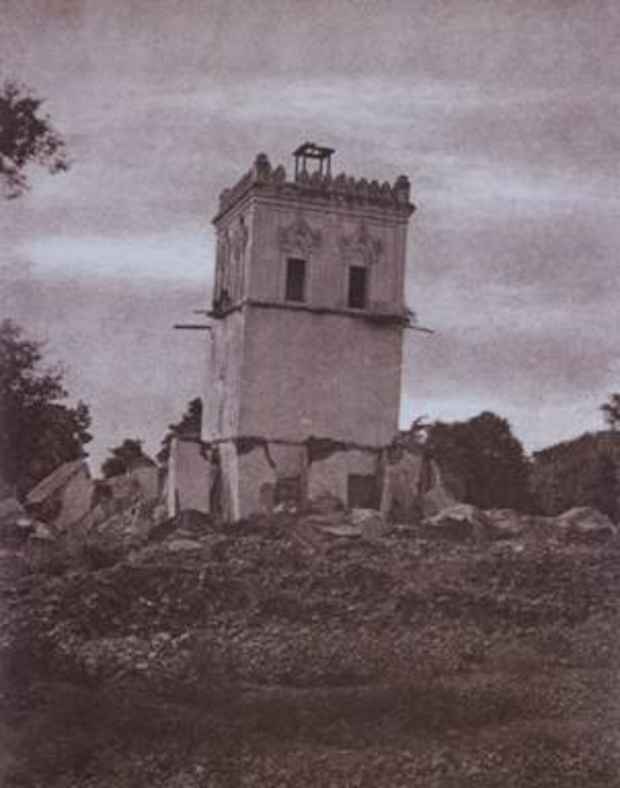Linnaeus Tripe “Photographs of Burma and India”
Hans P. Kraus, Jr. Fine Photographs

[Image: Linnaeus Tripe "Ava, Tower of the Palace, Burma} (1855) Albumenized salt print from a waxed paper negative, 33.7 x 26.6 cm]
This event has ended.
Nineteenth-century views of Burma and India by Captain Linnaeus Tripe will be on view at Hans P. Kraus Jr. Fine Photographs. The exhibition of 21 salt prints coincides with the exhibition at The Metropolitan Museum of Art, Captain Linnaeus Tripe: Photographer of India and Burma, 1852-1860, which opens on February 24.
Tripe (English, 1822-1902) used the early photographic technique of waxed paper negatives, most often with clouds skillfully painted in, to produce remarkable images of pagodas, temples, and landscapes.
After serving a decade in the army in India as a cadet, Tripe returned to England in 1850 on leave. From 1851-54, he began to experiment with photography in his native Devonport and the exhibition includes one of Tripe’s earliest surviving pictures, Devonport, Richmond Walk, made during that time.
Returning to India as a captain in 1854, Tripe took leave from his regiment to take pictures of temples that had never been photographed. This substantial body of work was shown in the Madras Exhibition of Raw Products, Arts, and Manufactures of Southern India, in early 1855, when the jury reported that Tripe’s work was the “best series of photographic views on paper.” As a result, his images came to the attention of notables, including the 1st Marquess of Dalhousie, Governor-General of India. Hoping to secure a peace treaty with the Burmese, Lord Dalhousie sent a diplomatic mission to the Court of Ava at Amerapoora, Burma (Myanmar) in the summer of 1855. Linnaeus Tripe was appointed the official photographer.
The journey up Burma’s Irrawaddy River proved demanding. Tripe later noted that his photographic project had been severely curtailed by “unfavourable weather, sickness, and the circumstances unavoidably attending such a mission.” Nevertheless, Tripe’s images of Burma were very well received. The jury at the 1857 Madras Exhibition, where the Burma pictures were on view, declared them “excellent, remarkable for great distinctness and their unusual and beautiful tint.” A fellow artist noted that “Captain Tripe’s beautiful photographs render description needless.”
The exhibition includes a striking image of a leaning watchtower from the Burma trip, Ava, Tower of the Palace, Burma, 1855. Tripe wrote, “This is the only coherent remains of the palace. The earthquake of 1839 covered the ground with the rest of it and tilted this considerably.”
Based on his successful work in Burma, Tripe was hired to work for the Madras government and began in 1857. As with Burma, he made some of the first photographs ever taken of South India: images of celebrated architectural sites and important natural landmarks that gave visual evidence to the region’s culture, art, and religion. He also chose subjects directly related to the military conquests of the British as they extended their authority over the region. One such image, Beekinpully, Veerabuddradroog, Madras, India, 1857-1858, depicts a hill fort built by Tipu Sultan, a bitter enemy who was eventually defeated and his numerous forts and palaces destroyed.
A number of photographs in Linnaeus Tripe: Photographs of Burma and India are from the collection of Jay McDonald. Work by Tripe can be found in the collections of The Metropolitan Museum of Art, New York; the National Gallery, Washington, D.C.; the J. Paul Getty Museum, Los Angeles; and the British Library, London.
Media
Schedule
from February 17, 2015 to May 15, 2015